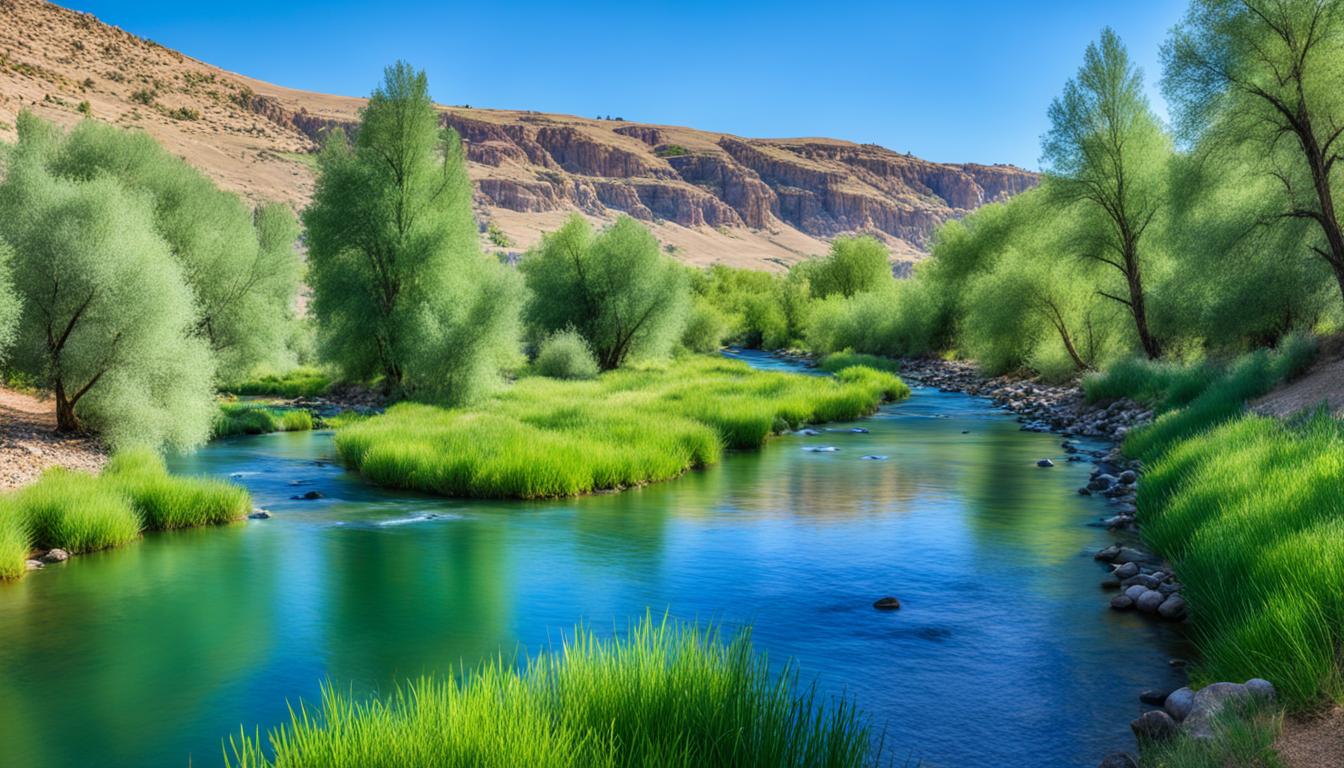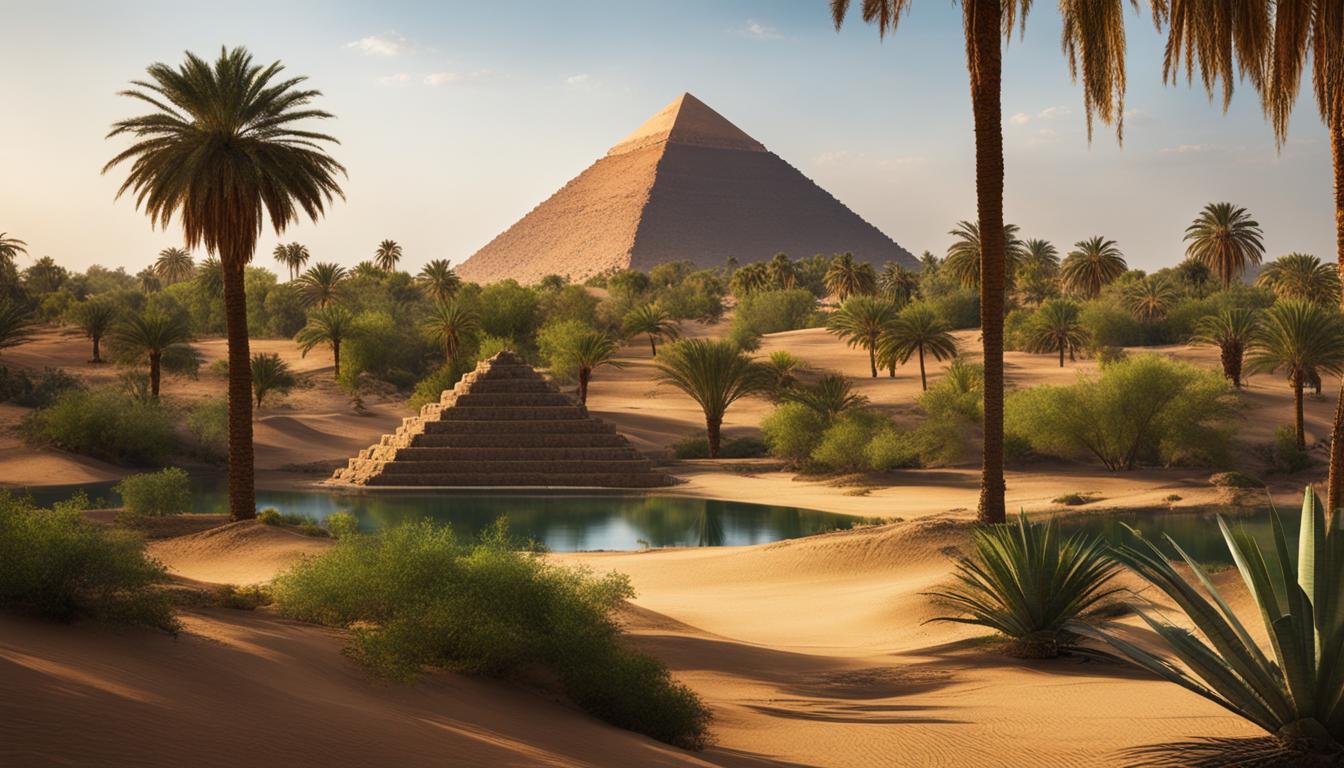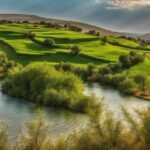The Jordan River is a significant river in the Middle East, running along the border between Jordan, Israel, the Palestinian West Bank, and Syria. It has great religious and historical significance, featuring prominently in the Bible and serving as a pilgrimage site for Christians. The river runs from north to south, starting at the Sea of Galilee and flowing into the Dead Sea. The Jordan River is known for its role in biblical events, such as the crossing of the Israelites into the Promised Land and Jesus’ baptism by John the Baptist.
Key Takeaways:
- The Jordan River is a significant river in the Middle East, running along the border between Jordan, Israel, the Palestinian West Bank, and Syria.
- The river holds great religious and historical significance, featuring prominently in the Bible and serving as a pilgrimage site for Christians.
- It is known for its role in biblical events, such as the crossing of the Israelites into the Promised Land and Jesus’ baptism by John the Baptist.
- The Jordan River runs from north to south, starting at the Sea of Galilee and flowing into the Dead Sea.
- It is a site of immense cultural, religious, and natural importance.
Explore the significance, history, geography, and cultural importance of the Jordan River in the sections below.
The Significance of the Jordan River in the Bible
The Jordan River holds immense religious significance in the biblical context, particularly in Judaism and Christianity. This iconic river has played a pivotal role in shaping the faith and spirituality of believers for centuries.
According to the Bible, the Jordan River holds tremendous biblical importance through the stories of the Israelites. Under the guidance of Joshua, they crossed the Jordan River, leading to the fulfillment of God’s promise to bring them to the Promised Land. This event symbolizes a journey of faith, hope, and the beginning of a new chapter for the children of Israel.
“Joshua said to the Israelites, ‘You have never been this way before. Keep your eyes on the ark of the covenant of the Lord your God… As soon as the priests who are carrying the ark of the Lord… come to the edge of the Jordan, they will stand in the flowing water… And as soon as the priests… touch the water, its flow will be cut off and it will stand up in a heap.’”
Furthermore, the Jordan River is renowned for its association with the baptism of Jesus Christ by John the Baptist. This event is considered a moment of spiritual significance in Christianity and represents purification, rebirth, and the initiation of Jesus’ earthly ministry. It serves as a cornerstone in Christian theology and echoes the transformative power of faith.
The historical significance of the Jordan River cannot be overstated either. It has witnessed numerous biblical events, ancient civilizations, and cultural interactions throughout history. The river’s ability to connect people to their spiritual roots has made it a site of pilgrimage and a symbol of unwavering devotion.
Embracing the Jordan River as a sacred space, believers find solace, inspiration, and a physical connection to the foundations of their faith. The river’s religious and historical importance reverberates through the hearts and minds of those who seek spiritual enlightenment and a profound connection with biblical heritage.
Key Takeaways:
- The Jordan River holds immense religious significance in Judaism and Christianity.
- It symbolizes the fulfillment of God’s promise to bring the Israelites to the Promised Land.
- The river is the site of Jesus’ baptism, marking the beginning of his earthly ministry.
- The Jordan River is a symbol of faith, spirituality, and redemption for believers.
Geography and Location of the Jordan River
The Jordan River is located in the Middle East, running along the border between Jordan, Israel, the Palestinian West Bank, and Syria. It is a significant river with diverse geographical features and physical characteristics.
Location
The Jordan River originates from the confluence of the Hasbani River and the Dan River in northern Israel. From there, it flows southward for approximately 251 kilometers (156 miles), serving as a natural border between Jordan and Israel, as well as the Palestinian West Bank.
Physical Characteristics
The Jordan River showcases a unique blend of physical characteristics. It begins at an elevation of 70 meters (230 feet) above sea level and descends along its course, reaching a depth of 416 meters (1,365 feet) below sea level at the Dead Sea, where it ultimately mouths.
The river runs through the famous Sea of Galilee, which acts as a major water source for both the Jordan River and the surrounding areas. The Sea of Galilee is 209 meters (686 feet) below sea level, making it one of the lowest freshwater lakes in the world.
Throughout its journey, the Jordan River receives water from various tributaries, including the Banias River, Dan River, Yarmouk River, and Zarqa River. These tributaries contribute to the overall flow and ecological diversity of the Jordan River system.
[List of tributaries and their significance]
| Tributary | Location | Importance |
|---|---|---|
| Banias River | Near Mount Hermon in the Golan Heights | Supplies water to the Jordan River and contributes to its flow |
| Dan River | Near the Banias Spring in Northern Israel | Forms the primary source of the Jordan River |
| Yarmouk River | Forms part of the border between Jordan and Syria | Contributes significant water volume to the Jordan River |
| Zarqa River | Flows from the eastern slopes of the Golan Heights | Contributes water and sediment to the Jordan River |
The journey of the Jordan River culminates at its mouth, where it empties into the Dead Sea. The Dead Sea is a unique saltwater lake known for its high salinity and mineral-rich composition.
The Jordan River’s geography and location make it a vital water source, a natural border, and an integral part of the region’s ecosystem.
History of the Jordan River
The Jordan River boasts a fascinating history that spans thousands of years. This iconic waterway holds significant importance, particularly in biblical events and the rise and fall of ancient civilizations.
Throughout the Bible, the Jordan River is mentioned in numerous stories, most notably in the accounts of the Israelites’ journey to the Promised Land. It served as a significant landmark as the Israelites crossed over its waters, following the leadership of Joshua.
The river played a pivotal role in the lives of ancient civilizations that inhabited its banks. The Canaanites, Philistines, and Israelites all regarded the Jordan River as a vital resource and a witness to their triumphs, conflicts, and religious ceremonies.
Today, the Jordan River continues to captivate the imagination of historians, archaeologists, and tourists from around the globe. Its historical importance and archaeological significance attract visitors seeking to explore the remnants of the past and uncover ancient secrets.
“The Jordan River stands as a testament to the triumphs and struggles of ancient civilizations, preserving their stories and teachings for generations to come.”
The history of the Jordan River is one that evokes wonder and invites exploration, making it a compelling destination for those seeking to connect with the rich tapestry of human civilization.
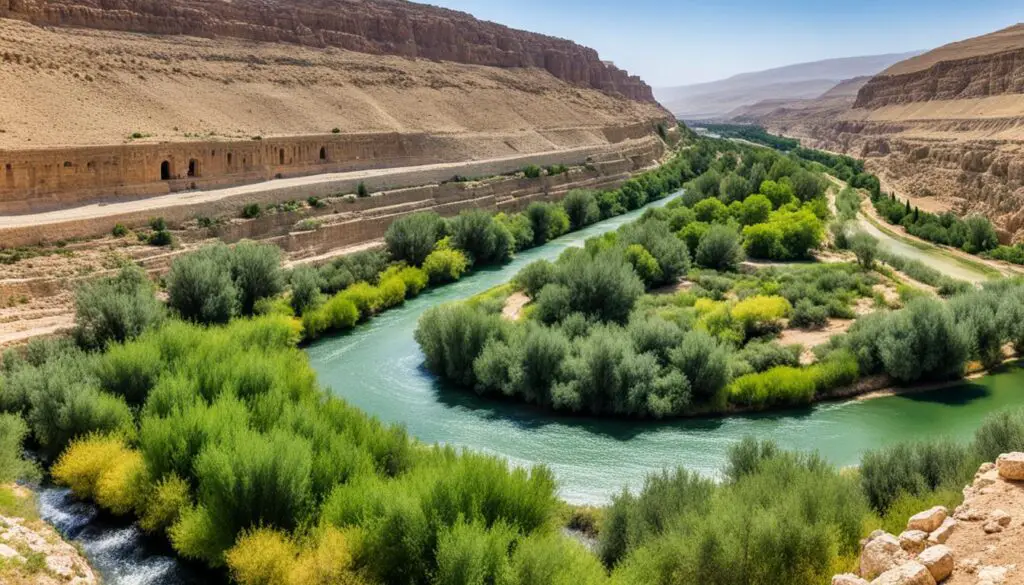
Archaeological Treasures along the Jordan River
Exploring the banks of the Jordan River unveils a treasure trove of archaeological sites that shed light on the region’s ancient civilizations. One such site is the biblical city of Jericho, renowned as one of the oldest inhabited cities in the world.
Further south, the ruins of Beth Shean provide a glimpse into the Hellenistic and Roman periods. The distinguished archaeological remains highlight the cultural exchange and architectural advancements of the time.
By journeying along the Jordan River, visitors can step back in time and witness the footprint of ancient civilizations that left an indelible mark on the region’s history.
Natural Environment of the Jordan River
The Jordan River boasts a remarkable and diverse ecosystem, encompassing not only the river itself but also its surrounding areas. The river’s basin serves as a convergence point for various biogeographic regions, resulting in a rich tapestry of wildlife and plant species.
The Jordan River is teeming with a wide variety of fish species, many of which are endemic to the region. Some notable fish species found in the river include the Jordan bream, Jordan barbel, red garra, and hillstream loaches. These species have adapted to the unique conditions of the river, making the Jordan River a haven for aquatic biodiversity. Additionally, the river’s waters sustain populations of catfish, cichlids, and blennies, further contributing to its rich aquatic ecosystem.
The Jordan Valley, through which the river flows, showcases a distinct landscape characterized by steep walls and ravines. This rugged terrain provides a habitat for various wildlife, including migratory birds. The valley serves as an important stopover for birds during their long-distance migrations, making it a haven for birdwatchers and nature enthusiasts.
Efforts are underway to preserve the ecological balance of the Jordan River and safeguard its natural resources. Conservation initiatives focus on protecting and restoring the habitats of the river’s wildlife, ensuring the long-term sustainability of the ecosystem. By preserving the natural environment of the Jordan River, we can not only protect its diverse wildlife but also maintain the delicate balance of this unique ecosystem for generations to come.
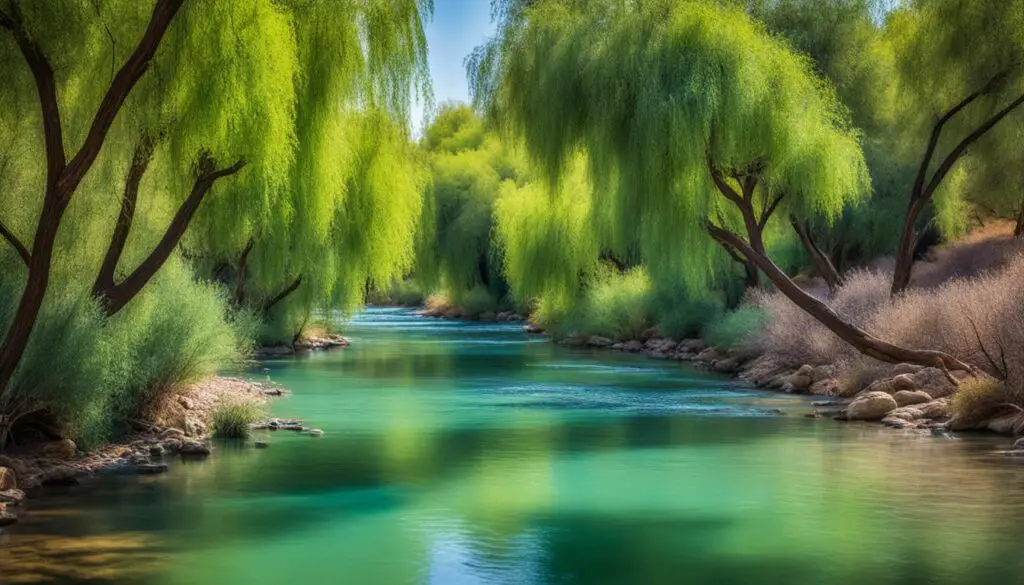
A diverse and unique ecosystem thrives in the Jordan River, supported by its basin’s meeting point of various biogeographic regions. The river’s waters sustain a rich array of fish species, while its valley provides a habitat for migratory birds and other wildlife. Conservation efforts aim to preserve this natural heritage for future generations.
Tourism and Cultural Significance of the Jordan River
The Jordan River is an enchanting destination that draws tourists from diverse religious and cultural backgrounds. Its unparalleled cultural and religious significance combined with its picturesque landscapes make it a must-visit location. Visitors flock to the river to experience its sacredness and to reenact the biblical event of baptism. Pilgrims, in particular, come to the Jordan River to connect with their faith and pay homage to biblical figures like John the Baptist.
The riverbanks of the Jordan River are adorned with an array of pilgrimage sites, churches, and monasteries. These holy sites offer spiritual retreats and host religious ceremonies, allowing visitors to immerse themselves in a deeply meaningful and transformative experience. Here, individuals can find solace, seek enlightenment, and reaffirm their faith through prayer and reflection.
Moreover, the Jordan River offers a myriad of activities for tourists to partake in. Adventurous souls can hike along the river’s scenic trails, taking in the awe-inspiring natural beauty that surrounds them. Canoeing is also a popular choice, allowing visitors to navigate the gentle currents and soak in the serenity of their surroundings. History enthusiasts will find delight in exploring the ancient ruins that grace the riverbanks, each with its own fascinating story to tell.
“The Jordan River is a place of peace, solace, and spiritual rejuvenation. Visiting this sacred site is a transformative experience that leaves a lasting impression on the hearts and minds of all who venture here.” – Travel enthusiast
Notable Sites Along the Jordan River:
| Site | Description |
|---|---|
| Baptism Site | A location traditionally believed to be the site where Jesus was baptized by John the Baptist. Pilgrims flock here to renew their faith through baptism and witness the significance of this momentous event. |
| Mount Nebo | A mountain where Moses is said to have viewed the Promised Land before his death. It offers breathtaking panoramic views of the surrounding landscapes and a chance to reflect on the spiritual journey of the Israelites. |
| Machaerus | Once a fortified palace, this archaeological site is believed to be the location where John the Baptist was imprisoned and beheaded. Its ruins offer a glimpse into the region’s ancient history and provide a thought-provoking setting for visitors. |
The Jordan River’s tourism appeal lies not only in its cultural and religious significance but also in its ability to create a sense of peace and spiritual connection. Visitors leave with a renewed sense of purpose and a deeper appreciation for the historical and sacred lands they have encountered.

Challenges Facing the Jordan River
The Jordan River, despite its religious and historical significance, is currently confronted with several pressing challenges. One of the major obstacles confronting the river is water scarcity, primarily due to the diversion of a significant portion of its flow for agricultural and domestic purposes. This excessive diversion has resulted in a substantial reduction in water levels, particularly in the lower course of the river.
Furthermore, the Jordan River is grappling with environmental degradation, including pollution and the depletion of natural resources. These factors pose a significant threat to the delicate ecosystem of the river. Pollution from various sources, such as industrial activities and agricultural runoff, has compromised water quality and harmed aquatic life. Additionally, excessive exploitation of natural resources, like sand and gravel extraction, has further disrupted the river’s ecosystem.
To address these challenges and ensure the preservation of the Jordan River for future generations, concerted efforts are being made by governments, conservation organizations, and local communities. These efforts aim to restore and protect the river’s ecosystem, implement sustainable water management practices, and raise awareness about the importance of preserving this invaluable natural resource.
Water scarcity and environmental degradation are significant challenges impacting the Jordan River. However, through collaborative action, we can safeguard this iconic river and foster its sustainable future.
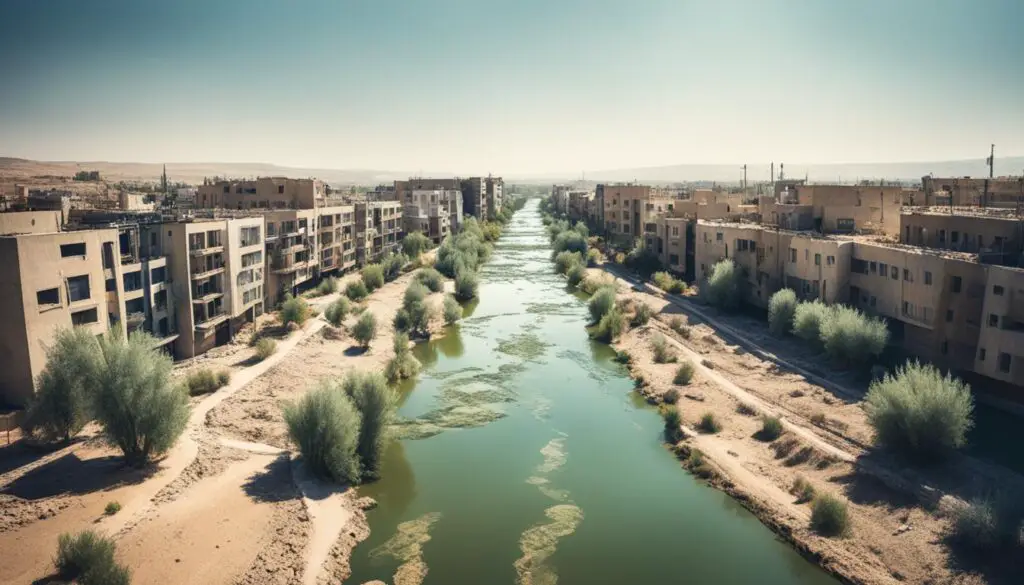
Efforts to mitigate water scarcity involve promoting water-saving techniques, improving irrigation practices, and implementing policies that ensure the equitable distribution of water resources. Conservation initiatives are being undertaken to prevent further degradation of the river’s ecosystem by reducing pollution and regulating industrial activities in the surrounding areas.
Local communities and conservation organizations are actively engaged in reforestation projects, which play a crucial role in preventing soil erosion, enhancing water quality, and creating habitats for diverse flora and fauna. Additionally, raising public awareness about the importance of preserving the Jordan River and its role in sustaining the region’s cultural and ecological heritage is essential for long-term conservation efforts.
By addressing the challenges of water scarcity and environmental degradation, we can work towards a sustainable future for the Jordan River, ensuring its continued significance for generations to come.
Efforts for Conservation and Restoration of the Jordan River
Many initiatives are underway to conserve and restore the Jordan River ecosystem. Governments, NGOs, and local communities are working together to implement sustainable water management practices and promote environmental stewardship. These efforts include reducing water consumption, implementing wastewater treatment systems, and raising awareness about the importance of preserving the river’s natural resources. Restoration projects aim to rehabilitate habitats, protect wildlife, and enhance the overall health of the Jordan River. It is hoped that these conservation efforts will ensure the long-term sustainability of the river and its surrounding environment.
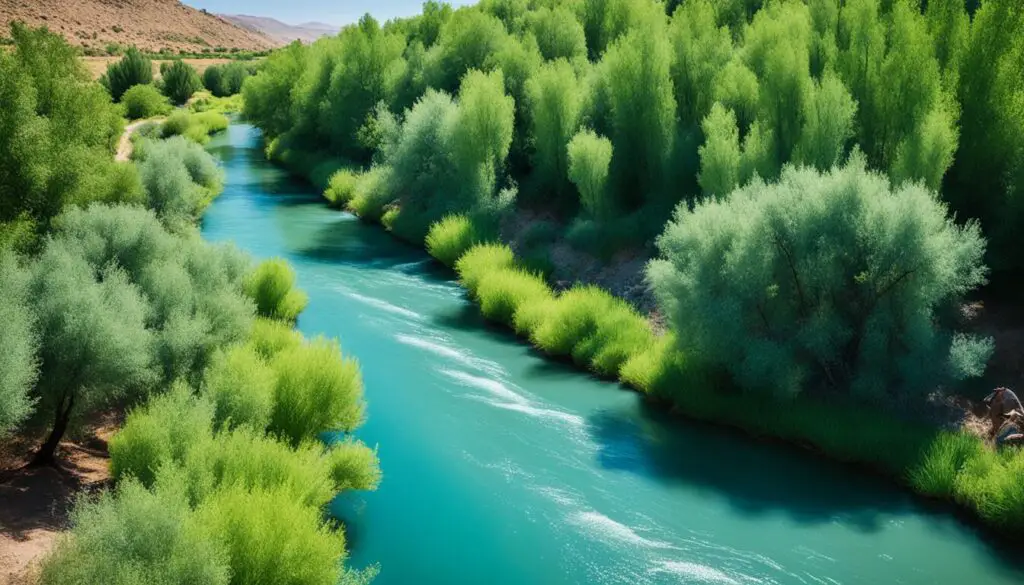
Conservation and Restoration Initiatives for the Jordan River
| Initiative | Description |
|---|---|
| Sustainable Water Management | Implementing strategies to reduce water consumption and ensure a more balanced distribution of water resources. |
| Wastewater Treatment | Establishing treatment systems to prevent pollution and safeguard the water quality of the Jordan River. |
| Awareness Campaigns | Raising public awareness about the significance of the Jordan River and the need for its conservation. |
| Habitat Rehabilitation | Restoring and preserving the natural habitats along the riverbanks to support diverse wildlife populations. |
Through these ongoing efforts, the Jordan River is receiving the attention it deserves for its ecological and cultural importance. By prioritizing conservation and restoration, we can safeguard this vital waterway for future generations and ensure the preservation of its unique ecosystem.
Future Prospects and Importance of the Jordan River
The future of the Jordan River holds significant importance for the region. Beyond its religious and cultural heritage, the river plays a crucial role in peacebuilding efforts between neighboring countries. Cooperation and shared management of the river’s resources can foster dialogue and understanding among communities, contributing to a more peaceful coexistence.
Additionally, the Jordan River’s future importance lies in its potential to support sustainable development and create opportunities for eco-tourism. Efforts to protect and restore the river will contribute to the preservation of its natural habitats, ensuring the survival of diverse ecosystems and wildlife. By recognizing the value of the Jordan River, future generations can continue to appreciate its historical, ecological, and symbolic significance.
“The Jordan River serves as a bridge, connecting people, cultures, and traditions. By nurturing this shared resource, we can build a future of harmony, conservation, and cooperation.”
The Cultural Heritage of the Jordan River
The Jordan River holds immense cultural heritage, as it is a significant pilgrimage site for people of various faiths. The river’s association with biblical events, such as Jesus’ baptism, adds to its religious importance. The Jordan River has witnessed countless individuals seeking spiritual renewal and connecting with their faith.
Furthermore, the Jordan River’s cultural heritage extends to its role in ancient civilizations. Throughout history, this river has been a source of life, attracting settlements and witnessing the rise and fall of numerous empires. Exploring the archaeological sites and ruins along the riverbanks offers a glimpse into the rich history of the region.
The Jordan River as a Catalyst for Peacebuilding
The Jordan River serves as a symbol of unity and shared resources, offering opportunities for peacebuilding among neighboring countries. Cooperation in the management of the river’s water resources can promote dialogue and understanding, fostering diplomatic relations and peaceful coexistence.
Efforts to address and resolve water scarcity issues in the region can contribute to long-term stability and peace. By prioritizing sustainable water management practices and finding equitable solutions, communities can build trust and create a foundation for peaceful relationships.
The Vision for a Sustainable Jordan River
In envisioning a sustainable future for the Jordan River, preserving its ecological integrity is paramount. By implementing conservation measures and sustainable land use practices, stakeholders can protect the river’s natural habitats, promoting biodiversity and ensuring the survival of endangered species.
Eco-tourism presents an opportunity for sustainable development along the Jordan River. Responsible tourism practices that prioritize environmental preservation and cultural sensitivity can help generate economic benefits for local communities while safeguarding the region’s natural and cultural heritage.
| Benefits of a Sustainable Jordan River: | Actions for Conservation and Peacebuilding: |
|---|---|
| Preservation of natural habitats | Cooperation and shared resource management |
| Support for biodiversity and wildlife | Promotion of sustainable water management |
| Economic opportunities through eco-tourism | Promotion of dialogue and understanding |
In conclusion, the future prospects of the Jordan River hold immense significance for the region’s sustainability, cultural heritage, and peacebuilding efforts. By recognizing the importance of cooperative resource management, cultural preservation, and ecological conservation, stakeholders can work towards a future where the Jordan River continues to thrive as a symbol of unity and a catalyst for peace.
Conclusion
The Jordan River stands as a remarkable waterway that holds deep religious and historical significance. It has played a crucial role in biblical stories, serving as a site of pilgrimage for believers across the globe. With its diverse geography, vibrant ecology, and rich cultural importance, the Jordan River continues to captivate the hearts of tourists seeking spiritual enrichment and an appreciation for the wonders of nature.
From its source in northern Israel to its mouth at the Dead Sea, the Jordan River weaves its way through ancient lands, carrying centuries of myth and spirituality. It has witnessed the Israelites’ crossing into the Promised Land and been the very site where Jesus was baptized by John the Baptist, a profound event in Christian theology. The river’s flowing waters and sacred surroundings have instilled a sense of awe and reverence in the hearts of countless pilgrims and visitors.
However, the Jordan River faces challenges that threaten its delicate balance. Water scarcity, environmental degradation, and the depletion of natural resources pose significant risks to the river’s ecosystem. To ensure its preservation and sustainable development, collaborative efforts are required. By valuing and protecting this precious resource, we can safeguard the Jordan River’s enduring significance, not only for ourselves but also for the generations to come.
The journey along the Jordan River is a testament to the intertwined nature of history, faith, and the environment. It serves as a reminder of the deep connections between humankind and the natural world. As we navigate the challenges of the future, may we continue to cherish and preserve the Jordan River, an extraordinary testament to our shared cultural heritage and the splendor of our planet.
FAQ
What is the significance of the Jordan River in the Bible?
The Jordan River holds immense religious significance in Judaism and Christianity. It played a pivotal role in biblical events such as the crossing of the Israelites into the Promised Land and Jesus’ baptism by John the Baptist.
Where is the Jordan River located?
The Jordan River runs along the border between Jordan, Israel, the Palestinian West Bank, and Syria.
What are the physical characteristics of the Jordan River?
The Jordan River has a drop in elevation from 70 meters to 416 meters and is approximately 251 kilometers long. Its source is the confluence of the Hasbani River and the Dan River in northern Israel, and it flows into the Dead Sea.
What is the history of the Jordan River?
The Jordan River has a rich history dating back thousands of years. It is mentioned numerous times in the Bible and played a significant role in the lives of ancient civilizations such as the Canaanites, Philistines, and Israelites.
What is the natural environment of the Jordan River?
The Jordan River and its surrounding areas support a diverse ecosystem with a variety of fish species and wildlife. The Jordan Valley, through which the river flows, features steep walls and ravines, creating a distinct landscape.
Why is the Jordan River a popular tourist destination?
The Jordan River attracts tourists from various religious and cultural backgrounds who come to experience its sacredness and visit sites associated with biblical figures. It offers opportunities for activities like hiking, canoeing, and exploring ancient ruins.
What challenges does the Jordan River face?
The Jordan River faces challenges such as water scarcity, environmental degradation, and the depletion of natural resources. These issues require collaborative efforts to address and preserve the river for future generations.
What efforts are being made for the conservation and restoration of the Jordan River?
Governments, NGOs, and local communities are working together to implement sustainable water management practices, raise awareness, and undertake restoration projects to protect the Jordan River’s ecosystem and natural resources.
What is the future importance of the Jordan River?
The Jordan River holds significance not only in religious and cultural contexts but also in peacebuilding efforts between neighboring countries. Preserving and valuing the river’s resources can contribute to sustainable development and opportunities for eco-tourism.
